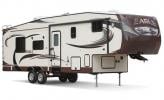 |
|
 03-29-2015, 03:07 PM
03-29-2015, 03:07 PM
|
#1
|
|
Junior Member
Join Date: Mar 2015
Location: Deptford
Posts: 18
|
What gauge wire do I need?
So I'm going to install an auxillary fuse block in a storage compartment in the trailer for LED lights and anything else down the road. The max amp for the block is 100 amp which I don't plan on coming anywhere close to. What size wire should I run from the battery to the block? I'm guessing it will be somewhere in the vicinity of 40 feet. Should I run wire like this?
Marine Wire 8/2 AWG Gauge Size Flat Duplex 8 AWG 2 Conductor Boat Cable Genuinedealz.com
Trailer is a 2015 SLX 264BHW.
|

|

|
 03-29-2015, 03:27 PM
03-29-2015, 03:27 PM
|
#2
|
|
Site Team
Join Date: Nov 2012
Location: Clearwater, FL area
Posts: 5,196
|
Quote:
Originally Posted by andrewjsmith

What size wire should I run from the battery to the block? I'm guessing it will be somewhere in the vicinity of 40 feet. Should I run wire like this?
|
You should run both a positive and a negative cable directly from the batteries to the rear storage compartment. I would fuse the Positive cable at both ends of the run. Here are a few charts to help you decide which size wire to use. You will have to make a decision on your MAX AMPS. It is better to go bigger than you think you may need. These are the charts I use.
Don
|

|

|
 03-29-2015, 04:03 PM
03-29-2015, 04:03 PM
|
#3
|
|
Senior Member
Join Date: Jan 2014
Location: Aurora CO
Posts: 2,334
|
It really depends on how many amps you intend to draw at that point, but based on your description it doesn't sound like a lot. I would agree with Mustang and fuse both ends, but use a fuse rating that matches the amps you intend to supply through appropriate cable size
__________________
Jim & Kim from Colorado
2014 Eagle 30.5 RLS
2015 Dodge 3500HD SRW 6.7L
Click on my profile for Mods and notes

|

|

|
 03-29-2015, 04:50 PM
03-29-2015, 04:50 PM
|
#4
|
|
Site Team
Join Date: Nov 2012
Location: Clearwater, FL area
Posts: 5,196
|
Quote:
Originally Posted by Jmooney

...use a fuse rating that matches the amps you intend to supply through appropriate cable size
|
2x
Don
|

|

|
 03-29-2015, 05:05 PM
03-29-2015, 05:05 PM
|
#5
|
|
Senior Member
Join Date: Jun 2012
Location: Sparta, TN
Posts: 1,174
|
Also consider if it a 40 ft distance one-way it is electrically an 80 ft run.
__________________
Chuck - Sparta, TN
2012 Jay Flight 22FB, 2 x Honda EU2000i
2013 GMC Yukon XL Denali AWD
EDUCATION is what you get when you read the fine print.....
EXPERIENCE is what you get when you don't.
|

|

|
 03-29-2015, 05:09 PM
03-29-2015, 05:09 PM
|
#6
|
|
Junior Member
Join Date: Mar 2015
Location: Deptford
Posts: 18
|
My original thought was running 8AWG because the LED lights draw so little amps I wouldn't need much. I think the LED light strip draws around 72 watts which should be 6 amps. I'm doing that and some LED strips to light the compartments so I'd guess they're the same draw.
I was going to run a 50 amp fuse even though I'd never come close to that draw. All lights are going to be on switches so they'd never all be on at once. Largest inline fuse holder I've seen is 6 AWG up to 60 amps.
But back to wire selection, would you recommend something like the 8/2 wire style? Or run individual positive and negatives?
|

|

|
 03-29-2015, 05:26 PM
03-29-2015, 05:26 PM
|
#7
|
|
Site Team
Join Date: Nov 2012
Location: Clearwater, FL area
Posts: 5,196
|
Quote:
Originally Posted by tnchuck100

Also consider if it a 40 ft distance one-way it is electrically an 80 ft run.
|
AWG gauges are calculated for both wires for a specific distance.
Don
|

|

|
 03-29-2015, 05:35 PM
03-29-2015, 05:35 PM
|
#8
|
|
Junior Member
Join Date: Mar 2015
Location: Deptford
Posts: 18
|
Coming off the battery now is a 12/2 and 10 awg wire that looks like it feeds the fuse panel now. That is run about halfway down the trailer. If they can run something that small, I should be fine with 8/2 wire to only power up 15 amps max
|

|

|
 03-29-2015, 07:23 PM
03-29-2015, 07:23 PM
|
#9
|
|
Site Team
Join Date: Nov 2012
Location: Clearwater, FL area
Posts: 5,196
|
Quote:
Originally Posted by andrewjsmith

If they can run something that small, I should be fine with 8/2 wire to only power up 15 amps max
|
The TT's wiring is coming off the battery and going about 15 feet, which is good for 30 amps.
Ok, lets look at the other side of this run. What will the voltage drop for the 12VDC battery for 30 feet of wire? Assuming the battery voltage is at 12VDC.
If you use 30 feet of 8AWG:
Voltage drop: 0.89
Voltage drop percentage: 7.42%
Voltage at the end: 11.11
If you use 30 feet of 6AWG wire:
Voltage drop: 0.56
Voltage drop percentage: 4.67%
Voltage at the end: 11.44
If you use 30 feet of 4AWG wire:
oltage drop: 0.35
Voltage drop percentage: 2.92%
Voltage at the end: 11.65
If you use 30 feet of 1/0 AWG wire:
Voltage drop: 0.14
Voltage drop percentage: 1.17%
Voltage at the end: 11.86
If you use 30 feet of 2/0 AWG wire:
oltage drop: 0.11
Voltage drop percentage: 0.92%
Voltage at the end: 11.89
These of course are calculations and are pretty much estimates, as there are a lot of things that can alter these numbers. Type of lugs, not 100% copper wire....
The decision is yours,
Just my thoughts,
Don
|

|

|
 03-29-2015, 07:30 PM
03-29-2015, 07:30 PM
|
#10
|
|
Senior Member
Join Date: Jun 2012
Location: Sparta, TN
Posts: 1,174
|
Quote:
Originally Posted by Mustang65

AWG gauges are calculated for both wires for a specific distance.
Don
|
In my experience AC circuits (120, 240, 480V, etc) are calculated as you suggest.
Low voltage DC circuits (12, 24,48V) are distance X 2.
__________________
Chuck - Sparta, TN
2012 Jay Flight 22FB, 2 x Honda EU2000i
2013 GMC Yukon XL Denali AWD
EDUCATION is what you get when you read the fine print.....
EXPERIENCE is what you get when you don't.
|

|

|
 03-29-2015, 09:04 PM
03-29-2015, 09:04 PM
|
#11
|
|
Senior Member
Join Date: Jan 2014
Location: Aurora CO
Posts: 2,334
|
Go as big a guage as you can manage for the wire pull. A 6 or 4 will provide enough capacity to handle as much amperage as you might need. You said you had a 100amp block. While you will never need 100amps up there, it would be nice to be able to up the fuse size and increase your power if you decided to add some large DC component .
My .02
__________________
Jim & Kim from Colorado
2014 Eagle 30.5 RLS
2015 Dodge 3500HD SRW 6.7L
Click on my profile for Mods and notes

|

|

|
 03-29-2015, 09:04 PM
03-29-2015, 09:04 PM
|
#12
|
|
Senior Member
Join Date: Feb 2014
Location: Owensboro, KY
Posts: 242
|
Mustang: I assume you got your voltage drops based on published resistance numbers or did you use the tables you posted? (I couldn't make them out.) If not they are in the tables of the NEC (I can get them for you if you'd like). Assuming your calculations are based on the correct resistance values (I don't have my code book handy right now) you have neglected to consider the voltage drop across the return path to the negative terminals of the battery - unless your tables take that into account. You have to consider that the voltage drop from the battery to the load, then across the load, then back to the negative battery terminal is going to be 12V. So 12V less the drop to the load and less the drop back to the negative terminal is what you have left across the load which you hope is something close to 12V. Single phase AC and DC voltage drops are calculated basically the same way i.e. distance x 2.
IMHO I would add an inline fuse at the source sized for the expected load so the wire size could be minimized. I wouldn't think LED lighting would amount to much current?
__________________
2015 Jayco 27DSRL (Sold and shopping for new 5er)
2016 Little Guy CIRRUS 800 Truck Camper
2015 GMC SLT 3500 Duramax Crew Cab, SRW

|

|

|
 03-29-2015, 09:21 PM
03-29-2015, 09:21 PM
|
#13
|
|
Senior Member
Join Date: Jan 2014
Location: Aurora CO
Posts: 2,334
|
Also consider that you are starting with higher than 12 volts, so the drop should still keep voltage + 12
__________________
Jim & Kim from Colorado
2014 Eagle 30.5 RLS
2015 Dodge 3500HD SRW 6.7L
Click on my profile for Mods and notes

|

|

|
 03-29-2015, 09:55 PM
03-29-2015, 09:55 PM
|
#14
|
|
Senior Member
Join Date: Apr 2013
Posts: 517
|
Quote:
Originally Posted by andrewjsmith

Coming off the battery now is a 12/2 and 10 awg wire that looks like it feeds the fuse panel now. That is run about halfway down the trailer. If they can run something that small, I should be fine with 8/2 wire to only power up 15 amps max
|
Yes, and yes.
You said storage compartment and LED lighting. How much more load could you possibly ever tag on? Another light maybe?
As a simple practical matter...
Install your #8 AWG wire and fuse it at 30 amps (a very conservative protection given your intended use). IF you ever overload that 30 amp fuse to failure, then you should be concerned and take the time to do more calculations.
vic
P.S. - That 30 amp fuse will never blow in my lifetime.
|

|

|
 03-30-2015, 05:39 AM
03-30-2015, 05:39 AM
|
#15
|
|
Site Team
Join Date: Nov 2012
Location: Clearwater, FL area
Posts: 5,196
|
I just went through my old numbers and the latest calculations and they changed the formula from automatically including the return run in the initial calculation. Now you need to x 2 the numbers in the calculation. Updated my notes.
Rechecked my TT's numbers and I am OK. I originally calculated mine when it was still included in the calculation.
Thanks for the info,
Don
|

|

|
 03-30-2015, 05:53 AM
03-30-2015, 05:53 AM
|
#16
|
|
Junior Member
Join Date: Mar 2015
Location: Deptford
Posts: 18
|
Didn't even think about this before but I could run the fuse block into the front compartment and only need about 8 feet. Then I can run all my LED lights from there. Better that way? I'd still have voltage drop from the panel to the lights, but I could manage with smaller gauge feeder wires.
|

|

|
 03-30-2015, 06:44 AM
03-30-2015, 06:44 AM
|
#17
|
|
Senior Member
Join Date: Aug 2013
Location: NC
Posts: 974
|
This should go without saying, but since the word fuse and breaker are used generically, and, there is a class for auto-reset breakers, I'll say it.
Use actual fuses. Never use auto-reset breakers for anything. I have no idea why they exist.
__________________
No man has a good enough memory to be a successful liar. Abraham Lincoln
2016 36FBTS Pinnacle
2016 F350, 6.7, 4x4, DRW, long bed
B & W Companion 5th wheel Hitch
|

|

|
 03-30-2015, 10:53 AM
03-30-2015, 10:53 AM
|
#18
|
|
Senior Member
Join Date: Sep 2010
Location: PNW
Posts: 5,195
|
Quote:
Originally Posted by Mustang65

You should run both a positive and a negative cable directly from the batteries to the rear storage compartment. snip
Don
|
Just curious. Why should a negative conductor be strung all the way from the battery? A connection to the trailer frame would provide the negative side of the circuit with a much shorter length of wire. That's how my main converter panel is connected.
__________________
Bill
2011 Dodge Ram 1500 HEMI Quad Cab
2011 Jay Flight 26BH
|

|

|
 03-30-2015, 03:15 PM
03-30-2015, 03:15 PM
|
#19
|
|
Senior Member
Join Date: Oct 2010
Location: Merrimack NH
Posts: 917
|
Andrew Based on your projected load , have a safety factor and lessen the voltage drop you should use 8/2 with ground (fused at 50A at both ends) nm cable or use a 8/3 sj cable. Nm or romex as it is called has solid conductors where as SJ cable has stranded conductors which are easier to work with. If you are going run under the tt you should use nm, if you are going inside through cabinets etc Sj cord will be ok if kept out of harms way. Larry
__________________
Larry & Rachel Demers 2013 F150 Eco Boost Super Cab 6.5 bed 6 sp. 3.31 4x4 White Hawk 28DSBH
|

|

|
 03-30-2015, 03:52 PM
03-30-2015, 03:52 PM
|
#20
|
|
Senior Member
Join Date: Jan 2015
Location: Surprise
Posts: 2,623
|
__________________
2011 Toyota Tundra double cab
2015 27RLS

|

|

|
 |
|
| Thread Tools |
Search this Thread |
|
|
|
| Display Modes |
 Linear Mode Linear Mode
|
 Posting Rules
Posting Rules
|
You may not post new threads
You may not post replies
You may not post attachments
You may not edit your posts
HTML code is Off
|
|
|
|
 » Recent Threads
» Recent Threads |
|
|
|
|
|
|
|
|
|
|
|
|
|
|
|
|
|
|
|
|
|
|
|
|
|
|
|
|
|
|
|
|
|
|
|
|
|
|
|
|
|